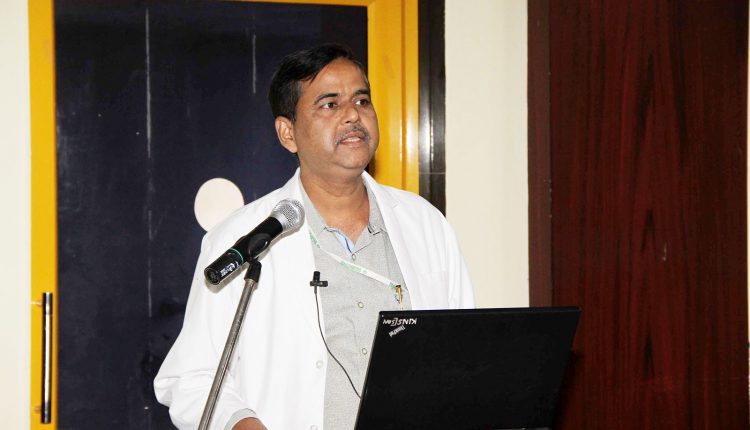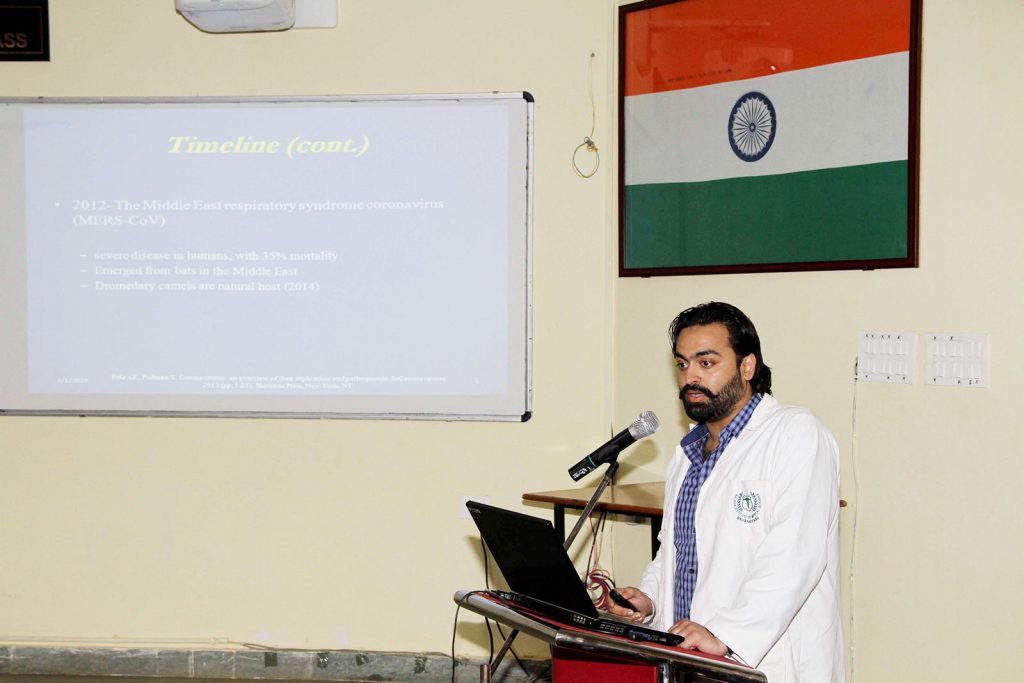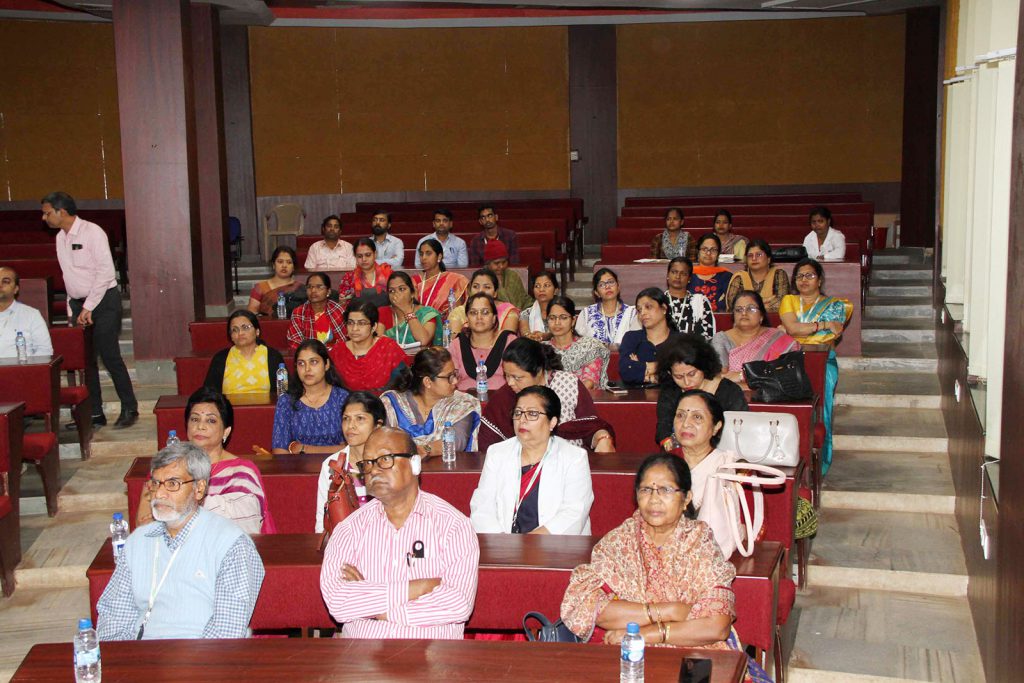A Lecture on “Corona Virus – A Global Threat” organized at KIMS
Kalinga Institute of Medical Sciences organized a Lecture on “Corona Virus – A Global Threat” on 1st February, 2020. Delivering the Lecture, Dr. Surya Narayan Mishra, Associate Professor of Microbiology Department & Infection Control Officer of KIMS(PBMH) discussed elaborately on “Standard Infection control strategies to prevent the spread of “Novel CoronaVirus(2019-nCoV)”.
Dr. Mishra elucidated that Corona viruses (CoVs), a subfamily of the Coronaviridae family, are positive strand RNA viruses with the largest genome of all known RNA viruses (≥27 Kb). Although the first member of the coronavirus family was discovered in the 1930s; corona viruses gained particular notoriety when the severe acute respiratory syndrome (SARS) outbreak shook the world in 2002–2003. Interest in this family of viruses grew in the aftermath of this epidemic, leading to the identification of many new family members.
This episode also shed light on the capabilities of corona viruses to jump across species. Before gaining importance for public health in 2003, the diseases associated with corona viruses were mainly of veterinary interest. Corona viruses infect a wide variety of mammals and birds, causing respiratory and enteric diseases and, in some rare cases, hepatitis and neurologic disease. Initially, many cases reported in the outbreak in Wuhan, China had some link to a large seafood and animal market, suggesting animal-to-person spread.
However, with increased number of cases being reported without any history of exposure to animal markets, suggests person-to-person transmission might be occurring. As per the recent data published by WHO (as on 02/02/2020), there are 14557 confirmed cases and out of them 14411 cases have been confirmed from China alone. The virus has been isolated from 23 more countries including India.
Considering the airborne spread through droplets as well as through inanimate objects coming in contact with suspected cases; the spread of the infection can be controlled by following certain precautionary measures as laid down by the WHO, which can be summarized as:
- Limit human-to-human transmission including reducing secondary infections among close contacts and health care workers, preventing transmission amplification events, and preventing further international spread from China
- Identify, isolate and care for patients early, including providing optimized care for infected patients
- Identify and reduce transmission from the animal source
- Address crucial unknowns regarding clinical severity, extent of transmission and infection, treatment options, and accelerate the development of diagnostics, therapeutics and vaccines
- Communicate critical risk and event information to all communities and counter misinformation
- Minimize social and economic impact through multi-sectoral partnerships.
WHO’s standard recommendations for the general public to reduce exposure to and transmission of a range of illnesses are as follows, which include hand and respiratory hygiene, and safe food practices:
- Frequently clean hands by using alcohol-based hand rub or soap and water;
- When coughing and sneezing cover mouth and nose with flexed elbow or tissue – throw tissue away immediately and wash hands;
- Avoid close contact with anyone who has a fever and cough;
- If you have a fever, cough and difficulty breathing seek medical care early and share previous travel history with your health care provider;
- When visiting live markets in areas currently experiencing cases of novel coronavirus, avoid direct unprotected contact with live animals and surfaces in contact with animals;
- The consumption of raw or undercooked animal products should be avoided. Raw meat, milk or animal organs should be handled with care, to avoid cross-contamination with uncooked foods, as per good food safety practices.
All individuals planning travel should seek advice on the potential hazards in their chosen destinations and understand how best to protect their health and minimize the risk of acquiring disease. Forward planning, appropriate preventive measures and careful precautions can protect their health and minimize the risks of accident and of acquiring disease.
WHO’S GUIDES TO PREVENT SPREAD OF CORONAVIRUS:
A. Protect yourself from getting sick:
Wash your hands with soap and water:
- When they are visibly dirty
- After coughing or sneezing
- When caring for the sick
- Before, during and after you prepare food
- After using the toilet
- After handling animals or animal waste
When coughing and sneezing; cover mouth and nose with flexed elbow or tissue. Don’t forget to throw the tissue into a closed bin. Avoid close contact when you are experiencing cough and fever and seek immediate medical care. Avoid spitting in public.
B. Food safety:
- Avoid consuming sick animals
- Use different chopping boards and knives for raw meat and cooked food.
- Wash your hands regularly while handling food.
- Use properly cooked food.
C. Travel safety:
- Avoid travel if you have fever and cough and seek medical care immediately.
- Share your travel history with the physician.
- While travelling; avoid close contact with symptomatic people having cough and fever.
- During travel use tissue to cover mouth and nose if you cough or sneeze.
- While travelling if you become sick; immediately sick medical attention by informing the crew staff.
- Eat only well cooked food while travelling.
D. Regarding pet animals:
Wash your hands regularly with soap and water while handling pets.
E. Vulnerable population:
Older people, and people with pre-existing medical conditions (like asthma, diabetes, heart disease) appear to be more vulnerable to becoming ill with the virus. They should regularly follow good hand hygiene and good respiratory hygiene.
The WHO has clearly suggested that wearing a medical mask is one of the prevention measures to limit the spread of certain respiratory diseases, including 2019- nCoV, in affected areas. However, the use of a mask alone is insufficient to provide an adequate level of protection and other equally relevant measures should be adopted. If masks are to be used, this measure must be combined with hand hygiene and other infection prevention measures to prevent the human-to human transmission of 2019-nCov.





